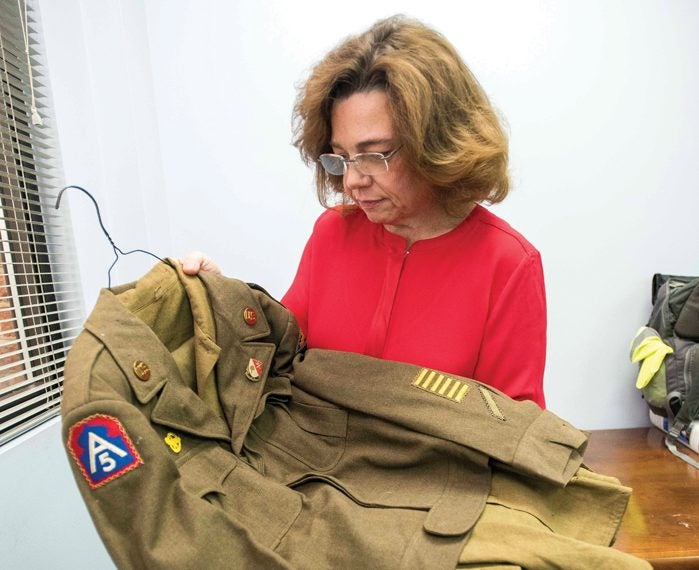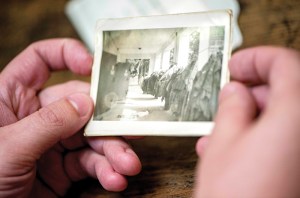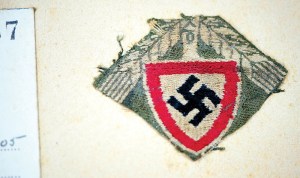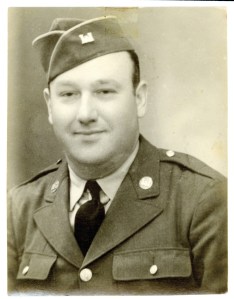World War II photos tell a story never spoken
Published 12:10 am Sunday, January 19, 2020

- JON C. LAKEY/SALISBURY POST Rowan County Fire Division Chief Deborah Horne (pictured) holds the heavy uniform of her grandfather James Bruton who was a PFC in the US Army who served in several countries in Europe during World War II. Horne and her family set out to learn how to better preserve the various items that belonged to her grandfather James Bruton. Bruton who worked for Cannon Mills in Concord after serving in the US Army stored away papers, photos, uniforms and other items related to his military service in Europe. Salisbury,North Carolina,1/14/20.
By Deirdre Parker Smith
deirdre.smith@salisburypost.com
No one had seen the photos for 45 years.
No one realized the extent of the late James Bruton’s experiences in World War II.
But when Deborah Horne, who works as Fire Division Chief for Rowan County, opened an old church envelope that had been in a box of things her aunt Karen Bruton sent her, she couldn’t believe what was inside.
“I was completely in shock. After being in the fire service for so long, I’ve seen some stuff, but I had never seen anything like that,” she said.
What she saw were several photos of Dachau Concentration Camp in Germany, pictures she’s pretty sure her grandfather took of the unspeakable horrors. The photos are too disturbing to publish in the newspaper — they show piles of emaciated dead bodies at the concentration camp, taken April 30, 1945, the day after the camp was liberated.
James Bruton was part of the cleanup unit that moved in after liberation, and both Horne and her aunt feel like Bruton never expected to see what he did.
There’s also a photo of the inside of one of the buildings, a hallway outside a gas chamber.
Horne had to know more; neither she nor her aunt had ever heard a word about Bruton’s service. He was in the Army from April 1942 through mid-September 1945, moving with his unit from Scotland through England, to North Africa and back to Europe.
Horne took the photos to Rowan Museum, where Executive Director Aaron Kepley immediately knew he was seeing something rare and extraordinary. He studied other photos of Dachau, and learned that Gen. Dwight David Eisenhower had ordered soldiers to take photos to document the atrocities.

JON C. LAKEY/SALISBURY POST Aaron Kepley, director of the Rowan Museum, holds one of the photos taken at the Nazi concentration camp at Dachau one day after it was liberated by Allied Forces.
Bruton served under Gen. George Patton as part of the cleanup force. What the liberators found in the concentration camps was beyond belief.
Different camps had different purposes. Dachau was a camp for mostly political and Christian prisoners, Roma (Gypsies), Jehovah’s Witnesses and Catholic priests, bishops and other clergy, with Jews arriving later in the war.
The photo of the chamber is not what everyone thinks it is, Kepley says. “I think that was a gas chamber, but it could be where they deloused the cloths of the dead.” Lice were a huge problem in the unsanitary camps. It could also be a cremation chamber.
Horne said seeing the photos was bad enough, but “imagine being there and having to smell it and hear it and see it right in front of you. … How did these men grieve over what they saw?”
She knew she did not want those photos stored in an attic. They needed to be preserved properly so future generations can see and know about the Holocaust.
“If people don’t believe it happened, here it is, right here. It happened, all right,” she said.
Kepley said one of the problems at Dachau at the end of the war was the site had run out of coal, so there was no fuel to burn the bodies of the dead. Train cars full of dying and dead prisoners had been sent to Dachau. Many of them had typhoid fever, which spread through the camp, killing unknown numbers.
History says executions at Dachau were by firing squad, a training ground for SS soldiers. The piles of the dead that Bruton saw could have been from starvation, lack of water or typhoid. The prison’s numbers had swelled at the end of the war as more prisoners were moved toward the front. Disease was rampant.
Kepley found similar pictures taken from a different angle at the camp, but of the same scene, and that confirmed Horne’s grandfather’s photos were real.
Kepley got the photos late on a Friday afternoon, and spent the weekend trying to figure out the best way to handle them. They are too gruesome for display in Rowan Museum, but would be available to people studying World War II. He contacted the Holocaust Museum in Washington, D.C., and officials there were interested. Then he thought about the visitor’s center and museum at Dachau, which has an extensive library and more than 6,000 photos. More than 800,000 people visit that museum each year.

JON C. LAKEY/SALISBURY POST A piece of woven fabric that contained a Nazi swastika that was brought back from the war in Europe after World War II.
He made a series of contacts through the U.S. Embassy and learned that the archivist at Dachau knew what the photos were.
“These are very significant photos for Rowan Museum to handle,” Kepley says.
Once the German embassy learned about the photos, they have been very helpful in assuring Kepley they will get the photos to the right place. “I hope it is something that will help people understand the Holocaust,” Kepley says.
Horne, who was just 4 months old when her grandfather died in 1972, did not know the photos were taken at Dachau. She’d never heard of Dachau, and no one in her family knew he had been there.
She wants the photos to be in the right place, as does her aunt Karen, who has vowed to take Horne to Germany to visit Dachau.
Horne wondered if she should even have the photos. She was so thankful that Kepley could explain to her what she was looking at it and what it all meant.
James Bruton was born in Kannapolis and was drafted into the Army in 1942. He had various jobs, including driving trucks in the Army, but when he came home, he went back to work as a loom fixer at a Cannon Mills location in Concord that made sheets and pillowcases.
His daughter, Karen, Horne’s aunt, said, “He never sat down and shared what he saw. He could not talk about the war. He always changed the subject.”
When Karen’s brother, Larry, died, he had his father’s collection of things from World War II. Karen has no children, and when she was cleaning out the house, she boxed things up and sent them to Horne.

JON C. LAKEY/SALISBURY POST Rowan County Fire Division Chief Deborah Horne and her family set out to learn how to better preserve the various items that belonged to her grandfather, James Bruton, here in his uniform.
Horne has her grandfather’s uniform from World War II and a scrapbook that contains some other items from the war. “He always kept everything. Absolutely everything.” On the first page of the scrapbook is a small swastika on a piece of cloth. “I have no idea where that came from,” she says.
There are cards from various Red Cross and USO stations, train tickets from England and other places in Europe. And a canvas armband from when Bruton and his unit entered France. The flag has just 48 stars, because Alaska and Hawaii were not yet states.
Horne has his discharge papers, which show the places he served — Italy, France, Germany, North Africa and Austria. She has his dog tags and her grandmother’s, who was a stateside nurse in the Navy during World War II. Horne now has her grandfather’s things, including his old uniform, and she’s eager to share it with future generations.
Horne never heard anyone say a bad word about her grandfather, and her aunt agrees.
Karen has no idea when or how her father took the photos. Her mother never talked about it, either.
“He wouldn’t answer questions” about it, Karen says. “I’m as surprised as anybody that he was in a German concentration camp. He never mentioned any part of what he did.
“I can’t imagine him, being a humble, Christian man, shooting people.”
When he came home, he just wanted to take care of his family, she says. He wanted her and her brother to see North Carolina, but he couldn’t afford hotels, so he got a tent and they camped all over. One of Karen’s favorites was the Outer Banks.
“When I’ve had to sleep on mud floors in Africa, it doesn’t bother me, because I slept on the ground on all those trips.”
Karen travels the world doing charitable work, especially with agriculture to help people increase their crops in struggling countries. She’s very proud of what she has been able to do and remembers how her father always did the best he could with what he had. “On a Sunday afternoon, I’d run to him and say, ‘Daddy, make me a kite’ and he’d grab some newspapers and go outside and get twigs. He’d tell me to go to the rag bag and he’d tie rags on the end and we had so much fun. I didn’t know any different.”
Her father, she said, taught so much about what was important in life. “He was a very quiet man.” Though she hadn’t thought about it until now, she says he was an inspiration. “He taught me to be independent and help people and be humble about it.
She’s glad the photos are going back to Germany, “to honor the people who had to go through all that.”
“I have such love for the man, such honor for him and I wish I had known this while he was still alive. It would have been something I would have forced him to talk about. He was a good man.”
He’s buried in Salisbury at the National Cemetery.
“I’m grateful for what my dad taught me to do from all that I’ve learned, and I’ve been able to serve people all over the world with no fear. I have to look back at that again and again.”




